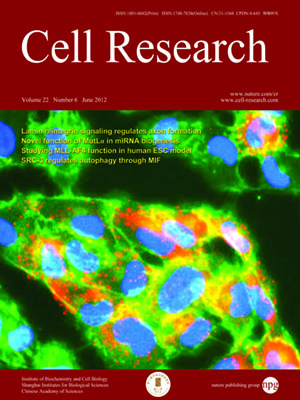
Volume 22, No 6, Jun 2012
ISSN: 1001-0602
EISSN: 1748-7838 2018
impact factor 17.848*
(Clarivate Analytics, 2019)
Volume 22 Issue 6, June 2012: 1022-1033
ORIGINAL ARTICLES
Microglial migration mediated by ATP-induced ATP release from lysosomes
Ying Dou1,*, Hang-jun Wu2,3,*, Hui-quan Li2, Song Qin1, Yin-er Wang2, Jing Li2, Hui-fang Lou2, Zhong Chen2, Xiao-ming Li2, Qing-ming Luo3 an
1Institute of Neuroscience and Key Laboratory of Neuroscience, Shanghai Institutes for Biological Sciences, Chinese Academy of Sciences, Shanghai 200031, China
2Department of Neurobiology, Key Laboratory of Medical Neurobiology of the Ministry of Health of China, Key Laboratory of Neurobiology of Zhejiang Province, Zhejiang University School of Medicine, Hangzhou, Zhejiang 310058, China
3Huazhong University of Science and Technology, Wuhan, Hubei 430030, Chi
Correspondence: Shumin Duan,(duanshumin@zju.edu.cn)
Microglia are highly motile cells that act as the main form of active immune defense in the central nervous system. Attracted by factors released from damaged cells, microglia are recruited towards the damaged or infected site, where they are involved in degenerative and regenerative responses and phagocytotic clearance of cell debris. ATP release from damaged neural tissues has been suggested to mediate the rapid extension of microglial process towards the site of injury. However, the mechanisms of the long-range migration of microglia remain to be clarified. Here, we found that lysosomes in microglia contain abundant ATP and exhibit Ca
2+-dependent exocytosis in response to various stimuli. By establishing an efficient
in vitro chemotaxis assay, we demonstrated that endogenously-released ATP from microglia triggered by local microinjection of ATPγS is critical for the long-range chemotaxis of microglia, a response that was significantly inhibited in microglia treated with an agent inducing lysosome osmodialysis or in cells derived from mice deficient in Rab 27a (ashen mice), a small GTPase required for the trafficking and exocytosis of secretory lysosomes. These results suggest that microglia respond to extracellular ATP by releasing ATP themselves through lysosomal exocytosis, thereby providing a positive feedback mechanism to generate a long-range extracellular signal for attracting distant microglia to migrate towards and accumulate at the site of injury.
Cell Research (2012) 22:1022-1033. doi:10.1038/cr.2012.10; published online 10 January 2012
FULL TEXT | PDF
Browse 2181


